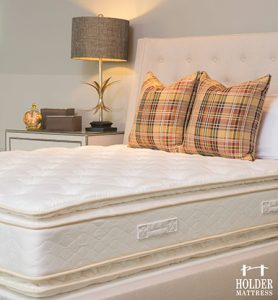I’ve watched trends in the mattress industry come and go. There is always something new and it never seems to stick around very long. Water beds were popular in the 1980s; ultra-luxe beds were a thing of the economic-booming 1990s; the 2000’s brought on “memory foam.” So as we’ve entered the second decade of this new millennium, we’ve also entered a new trend era in mattresses: Gel.
Sometimes it seems to me that if Dr. Scholl’s makes it in an insole, a mattress manufacturer is making it in queen size. After attending a recent international industry conference, we realized that gel is the new black. Every raw material supplier is pushing gel on manufacturers. It’s everywhere, in every form, size, shape, depth, etc… There are pros and cons:
Pros:
Gel is the answer to heat producing materials such as visco-elastic foam (memory foam) as it stays cool
Gel is flexibly contouring, ensuring support without pressure
Cons:
Gel is expensive
Gel is highly flammable
Gel is untested in durability
In short, my craftsman walked away from the idea of adding gel to our product line. To us, the cons outweigh the pros. Here’s why:
1) Gel is cool and will help regulate body temperature and allow other synthetics to stay cooler. The problem here is that gel is only effective in cooling the sleeper if that gel is on or near the surface of the mattress and not covered by any synthetic or non-breathable materials. In order to achieve this, the gel would need to be quilted. No one has quilted gel successfully yet with any significant depth. Furthermore, the price of gel as a raw material is deterring manufacturers from producing mattresses with large quantities of gel. It is typically being used as a 1/4″ layer well below several more layers of foam. This means you won’t be close enough to the gel to notice its benefits and you will pay more for the mattress. Even our raw material representatives who sell gel will be the first to tell you that it is merely a gimmick.
2) Flammability is a big issue in our industry. Standards changed drastically in 2007 causing manufacturers to add toxic chemicals to their products to ensure that they won’t go up in flames even if a blow torch is held to them. I unequivocally believe that flammability standards are too strict and that the “solution” will only cause a greater problem. We’re likely years away from learning the ill-effects of sleeping on known carcinogens, such as antimony trioxide, but that’s another blog… For manufacturers that choose to use gel in their products, flammability is a colossal issue. We recently received a letter from a supplier indicating that gel will not likely pass flammability standards with traditional means and amounts of flame retardant materials. Thus any manufacturer selling a gel product likely added copious amounts of toxic materials in order to pass the tests required for selling that product. At Holder Mattress, we use inherently flame retardant materials, such as wool, to pass these tests. Most manufacturers do not, and there is no requirement for them to tell you what materials they’ve used to ensure flame retardancy. Having gel in your mattress probably means you have more toxins as well.
3) To me, the most interesting thing in the mattress industry is the warranty. I found it odd that shortly after visco-elastic foam (I.e. memory foam) was invented, manufacturers were selling it with 20 year warranties. The product hadn’t even existed that long. Why would we want a customer to believe it will last that long when we really have no idea? As much of that time has now passed, we are seeing issues with the durability of that foam. New versions are being created all of the time and warranties mean less and less. Gel is too new for anyone to vouch for its durability. We are watching to see what happens, but we aren’t making any guarantees. Unfortunately, I cannot say the same for other manufacturers.
Gel may evolve to be a better, more viable bedding option. Until that point, we’d recommend other options. If you like the cooling effects, stick with natural materials that won’t hold heat, such as Talalay latex. If you want the contouring feel of gel, try to find a topper that you can place over an existing mattress that wont be required to meet the same flammability standards. If you want a mattress to last twenty years, buy one that has at least been in production for that long. We’ll always keep an eye on the latest trends and do our best to keep you informed about them. So don’t be gel-ous, it’s probably not as great as it sounds.



